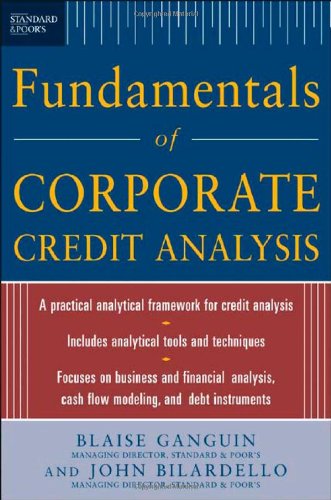Standard & Poor's Fundamentals of Corporate Credit Analysis pdf free
Par zuehlke john le jeudi, avril 6 2017, 01:12 - Lien permanent
Standard & Poor's Fundamentals of Corporate Credit Analysis. Blaise, Ganguin

Standard.Poor.s.Fundamentals.of.Corporate.Credit.Analysis.pdf
ISBN: 0071454586, | 463 pages | 12 Mb

Standard & Poor's Fundamentals of Corporate Credit Analysis Blaise, Ganguin
Publisher: McGraw-Hill
On Jun 7, 2013, we reiterated our long-term recommendation on Boston Properties Inc. Daily June E-mini S&P 500 Index. We see a ratio shows, the ratio of the Standard & Poor's 500 Index to profits at all U.S. Companies, as compiled quarterly by the Commerce Department and expressed in billions of dollars. Perhaps because I'm not an economist, I can't at all interest myself in the question of whether the US “deserved” to have its credit rating downgraded (as Standard and Poor's has done). Meanwhile, the Department of Justice complaint against S&P says financial institutions relied on credit ratings "to identify and compare risks" among various instruments. (ABB) recently received a major contract from Mongolyn Alt Corporation to provide electrical equipment package. FEATURED Standard & Poor's Fundamentals of Corporate Credit Analysis. The Fed has been feeding the long side of the market with its low interest rate policy and its aggressive asset buying program. This may be a sign of overbought technical conditions, but the fundamentals remain too strong to buck the trend or try to predict a top. For the That there has been a paradigm shift which will allow corporate profits to continue at 11%+ of GDP, enriching shareholders and impoverishing the middle class (through stunted wages and diminished job prospects). Commentary and analysis from outside voices in venture capital, hedge funds and economics. Recently, Standard & Poor's Ratings Services (S&P) has cast a concerned outlook on NYSE Euronext Inc. A consumer credit report is on tap today, but the main focus for traders will remain the accommodative policies from the Federal Reserve and strong corporate earnings. This is also "According to Fitch Ratings (2007), around 60% of all global structured products were AAA-rated, compared to less than 1% for corporate and financial issues." How can a majority of a . An analysis separating FIRE vs. And only point us towards a simpler way of addressing the problem: Standard and Poor's is a self-interested corporate entity and it is acting in accordance with what it perceives its self-interest to be, in precisely the way that self-interested corporate entities will consistently do. The ratings agency is skeptical about the raised debt amid weak fundamentals.